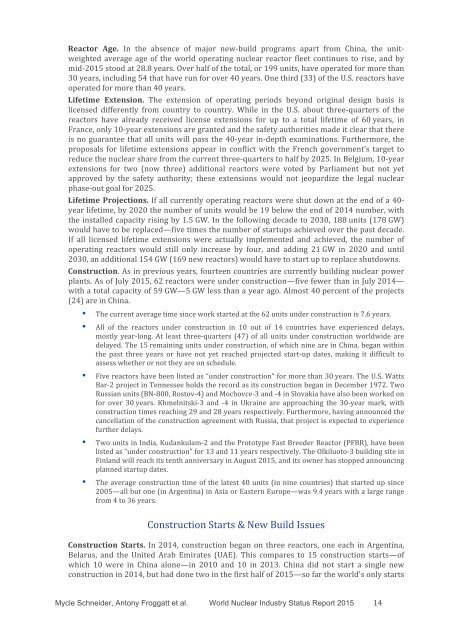PMFA1
PMFA1
PMFA1
Create successful ePaper yourself
Turn your PDF publications into a flip-book with our unique Google optimized e-Paper software.
Reactor Age. In the absence of major new‐build programs apart from China, the unitweightedaverage age of the world operating nuclear reactor fleet continues to rise, and bymid‐2015 stood at 28.8 years. Over half of the total, or 199 units, have operated for more than30 years, including 54 that have run for over 40 years. One third (33) of the U.S. reactors haveoperated for more than 40 years.Lifetime Extension. The extension of operating periods beyond original design basis islicensed differently from country to country. While in the U.S. about three‐quarters of thereactors have already received license extensions for up to a total lifetime of 60 years, inFrance, only 10‐year extensions are granted and the safety authorities made it clear that thereis no guarantee that all units will pass the 40‐year in‐depth examinations. Furthermore, theproposals for lifetime extensions appear in conflict with the French government’s target toreduce the nuclear share from the current three‐quarters to half by 2025. In Belgium, 10‐yearextensions for two (now three) additional reactors were voted by Parliament but not yetapproved by the safety authority; these extensions would not jeopardize the legal nuclearphase‐out goal for 2025.Lifetime Projections. If all currently operating reactors were shut down at the end of a 40‐year lifetime, by 2020 the number of units would be 19 below the end of 2014 number, withthe installed capacity rising by 1.5 GW. In the following decade to 2030, 188 units (178 GW)would have to be replaced—five times the number of startups achieved over the past decade.If all licensed lifetime extensions were actually implemented and achieved, the number ofoperating reactors would still only increase by four, and adding 21 GW in 2020 and until2030, an additional 154 GW (169 new reactors) would have to start up to replace shutdowns.Construction. As in previous years, fourteen countries are currently building nuclear powerplants. As of July 2015, 62 reactors were under construction—five fewer than in July 2014—with a total capacity of 59 GW—5 GW less than a year ago. Almost 40 percent of the projects(24) are in China.• The current average time since work started at the 62 units under construction is 7.6 years.• All of the reactors under construction in 10 out of 14 countries have experienced delays,mostly year‐long. At least three‐quarters (47) of all units under construction worldwide aredelayed. The 15 remaining units under construction, of which nine are in China, began withinthe past three years or have not yet reached projected start‐up dates, making it difficult toassess whether or not they are on schedule.• Five reactors have been listed as “under construction” for more than 30 years. The U.S. WattsBar‐2 project in Tennessee holds the record as its construction began in December 1972. TwoRussian units (BN‐800, Rostov‐4) and Mochovce‐3 and ‐4 in Slovakia have also been worked onfor over 30 years. Khmelnitski‐3 and ‐4 in Ukraine are approaching the 30‐year mark, withconstruction times reaching 29 and 28 years respectively. Furthermore, having announced thecancellation of the construction agreement with Russia, that project is expected to experiencefurther delays.• Two units in India, Kudankulam‐2 and the Prototype Fast Breeder Reactor (PFBR), have beenlisted as “under construction” for 13 and 11 years respectively. The Olkiluoto‐3 building site inFinland will reach its tenth anniversary in August 2015, and its owner has stopped announcingplanned startup dates.• The average construction time of the latest 40 units (in nine countries) that started up since2005—all but one (in Argentina) in Asia or Eastern Europe—was 9.4 years with a large rangefrom 4 to 36 years.Construction Starts & New Build IssuesConstruction Starts. In 2014, construction began on three reactors, one each in Argentina,Belarus, and the United Arab Emirates (UAE). This compares to 15 construction starts—ofwhich 10 were in China alone—in 2010 and 10 in 2013. China did not start a single newconstruction in 2014, but had done two in the first half of 2015—so far the world's only startsMycle Schneider, Antony Froggatt et al. World Nuclear Industry Status Report 2015 14


